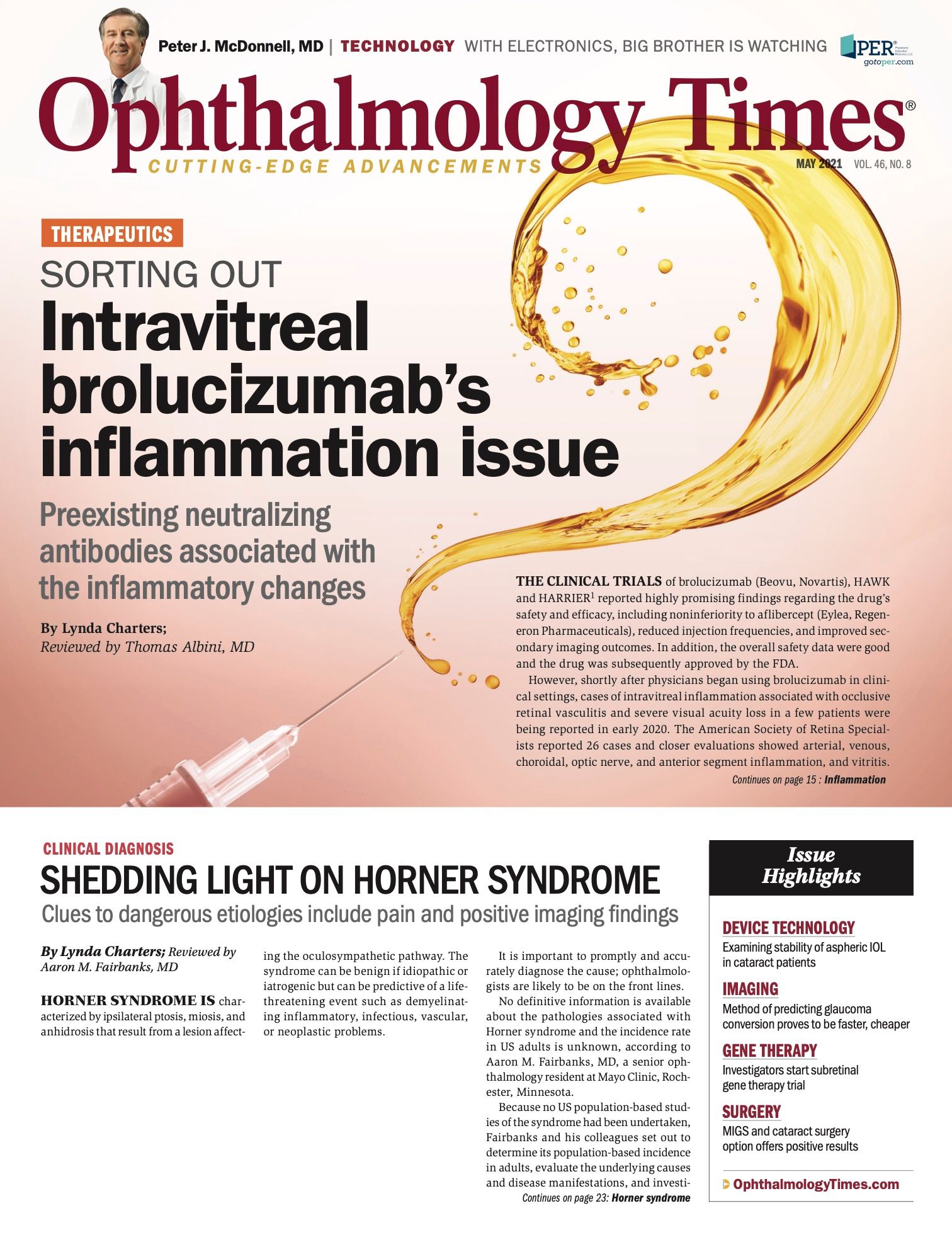Publication
Article
Digital Edition
Retinal nonperfusion, leakage linked with center-involved DME
Author(s):
Study results show that aflibercept-treated eyes are protected.

Reviewed by Dilsher Dhoot, MD
In the phase 3, double-masked PANORAMA study, retinal nonperfusion and leakage were associated with increased incidence of center-involved diabetic macular edema (DME) and vision-threatening complications in patients with nonproliferative diabetic retinopathy (NPDR), according to Dilsher Dhoot, MD, of Retina Consultants of America/California Retina Consultants in Santa Barbara, who reported the results on behalf of the study investigators.
The study
The PANORAMA study comprised 402 participants with moderately severe to severe NPDR rated 47 to 53 on the Diabetic Retinopathy Severity Scale (DRSS) who did not have baseline DME.
The participants were randomized to intravitreal aflibercept injection (IAI) (Eylea, Regeneron Pharmaceuticals) every 16 weeks following 3 monthly doses and one 8-week interval (n = 135), IAI 2 mg every 8 weeks following 5 initial monthly doses with as-needed dosing after week 52 (n = 134), or sham (n = 133). Dhoot noted that the patients were assessed through the 100 weeks of the study.
Related: DME strategies directed by knowledge of mechanisms
The topline data from PANORAMA showed that a significantly greater proportion of patients in both aflibercept arms achieved a 2-step or greater reduction (improvement) from baseline DRSS level at weeks 24, 52, and 100 versus the sham arm.
Primary end point was the proportion of patients improving 2 or more steps on the DRSS at weeks 24 and 52.
The secondary end points were the proportion of patients who developed PDR or anterior-segment neovascularization and the proportion of patients developing center-involved DME at week 100.
The post hoc analysis under discussion evaluated the impact of angiographic variables, specifically baseline retinal nonperfusion and leakage area, on the potential incidence of vision-threatening complications or center-involved DME in patients with moderately severe to severe NPDR, Dhoot explained.
Related: What an intravitreal integrin antagonist may bring to DME
Images obtained from the participants in the PANORAMA trial were graded at the Wisconsin Reading Center for baseline nonperfusion and baseline leakage: 45 had nongradable baseline nonperfusion area and 13 had nongradable baseline leakage area.
According to Dhoot, patients were stratified into no baseline nonperfusion (group 1) and 3 tertiles of increasing degrees of baseline nonperfusion area (groups 2, 3, and 4) for the retinal nonperfusion analysis and into four quartiles (1-4) based on the leakage area.
Dhoot noted that, at baseline, a greater number of patients with a DRSS score of 53 had increased nonperfusion. In addition, race, eg, African American, was associated with increasing nonperfusion area.
The mean hemoglobin A1C trended upward slightly from 8.38 in group 1 to 8.95 in group 4. The mean duration of diabetes trended down from 15.6 years in group 1 to 12.8 years in group 4.
Related: Post hoc analysis: Protocol V provides more practical DME guidance for clinicians
Regarding the cumulative incidence rate of any center-involved DME or vision-threatening complications through week 100, Dhoot reported an upward trend in the sham group as baseline nonperfusion area increased, but no differences were seen in the combined aflibercept groups.
The hazard ratios for any center-involved DME or vision-threatening complications were 1.32 and 1.06 in the sham and combined aflibercept groups, respectively.
“Aflibercept was favored in terms of the vision-complication rates or center-involved DME, and the complication rates increased in the sham groups,” Dhoot said.
An evaluation of center-involved DME based on the baseline nonperfusion also favored aflibercept over sham, with hazard ratios for the sham and aflibercept groups being 1.32 and 0.95, respectively.
Finally, evaluation of only vision-threatening complications based on baseline nonperfusion showed respective hazard ratios of 1.44 and 1.10 for sham and aflibercept, respectively.
Related: Study shows positive results in treatment of DME with faricimab
“The risk of developing center-involving DME and/or vision-threatening complications increased with increasing baseline nonperfusion area in sham-treated but not in aflibercept-treated patients,” Dhoot said. “Aflibercept reduced the incidence of vision-threatening complications or center-involving DME compared with sham regardless of the extent of the baseline area of nonperfusion.”
Of the 402 participants, 13 had nongradable leakage area at baseline. As with the nonperfusion groups, the number of participants with DRSS 53 increased with increasing leakage area (across, quartiles 1-4).
“With increasing leakage there is increasing numbers of patients with level 53 disease. The baseline level of nonperfusion also trended up moving from quartiles 1 to 4,” Dhoot said.
Regarding the mean hemoglobin A1C, there was also an upward trend from 8.18 in quartile 1 to 8.70 in quartile 4. The mean diabetes duration showed a downward trend from 16.9 years in quartile 1 to 12.7 years in quartile 4.
Related: Study shows positive results in treatment of DME with faricimab
Through week 100, the cumulative incidence of any vision-threatening complications or center-involved DME trended to increase as the increase of baseline leakage area with sham but no difference was observed among patients in the combined aflibercept arm, Dhoot said.
Regarding the incidence of center-involved DME, the sham group had an upward trend; in the aflibercept group, the incidence rate was blunted.
An increasing rate of center-involved DME was seen with increased baseline leakage in the sham and aflibercept groups. The hazard ratios favored aflibercept over sham, respectively, 1.03 and 1.02.
When considering only vision-threating complications, the sham group showed an upward trend, whereas the aflibercept group did not; the respective hazard ratios were 1.08 and 1.00.
“The risk of developing center-involved DME and/or vision-threatening complications increased with increasing baseline leakage in the sham-treated patients but not in the aflibercept-treated patients,” Dhoot said. “Aflibercept reduced the incidence of center-involved DME and/or vision-threatening complications.”
Related: Identifying gaps in anti-VEGF treatment among minorities with DME
Dhoot concluded that the increasing retinal nonperfusion and leakage areas were associated with increased rates of center-involved DME and vision-threatening complications in the sham group.
“These associations were not seen in the aflibercept group,” he said. “It appears that it may be helpful to first identify those patients who are at risk in levels 47 and 53 and that retinal nonperfusion and the area of leakage are important considerations when managing patients with NPDR and deciding whether to treat these often well-sighted patients.”
In analyses of data from week 52 and week 100, there were no treatment-by-subgroup interactions for any baseline factors. In addition, both dosing regimens of aflibercept maintained statistical superiority over sham in all baseline factor subgroups.
The PANORAMA data are expected to be reported soon.
--
Dilsher Dhoot, MD
e:ddhoot@yahoo.com
This article was adapted from Dhoot’s presentation at the Bascom Palmer Angiogenesis, Exudation, and Degeneration 2021 virtual meeting in February. He is a consultant for Regeneron Pharmaceuticals.

Newsletter
Don’t miss out—get Ophthalmology Times updates on the latest clinical advancements and expert interviews, straight to your inbox.





